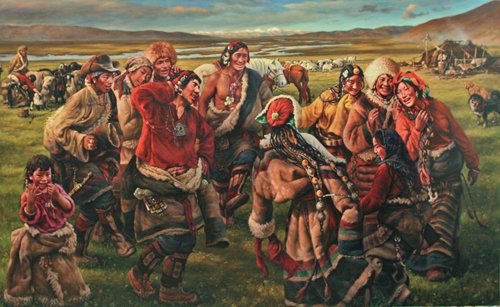pei zhuangxin
裴莊欣 ,中國美術家協會、 [1] 西藏自治區美術家、攝影家協會會員。西藏美術館籌建委員會特聘外籍專家。 1956年四川成都出生 ,1971年下鄉到西藏昌都,1978年考入四川美術學院油畫係,畢業後重返西藏工作,1989年獲 “美中文化教育交流基金會”
Pei Zhuangxin Photo: He Keyao/GT

Dance on the Grass by Pei Zhuangxin Photo: Courtesy of Pei Zhuangxin
When Pei Zhuangxin first went to the Tibet Autonomous Region in the early 1970s at the age of 15, he never imagined that he would one day become a celebrated artist. He also never expected that this remote plateau would remain a continual theme for his creations throughout his artistic career.
Pei, the well-known Chinese American painter who has had studios in both New York and Beijing, is known for his Tibetan-themed works. His representative works, such as Nomads Family and Dance on the Grass, are widely known and have been highly praised in fine art circles. Painting Tibet for more than half a century, he uses his brushes to express his deep love for the place that is intimately tied with his youthful memories of the 1970s and 1980s.
Eternal memories
"To me, Tibet is not only a source of artistic creation, but a place that carries unique values and memories. Drawing it has already become an essential part of my life," Pei told the Global Times.
Pei started to work as an auto mechanic in Tibet's Changdu area in 1971 after graduating from middle school. Like many young people at the time, known as "Zhi Qing" or educated youth, Pei decided to devote himself to the development of the country's border areas. However, his talent for painting distinguished him from other colleagues in the auto shop and ended up changing his life.
"First, I just helped paint posters for local events and gradually I was given the opportunity to work as a full-time painter. I feel grateful to Tibet since it kicked off my artistic pursuits," Pei said, talking about his early years living on the plateau.
The beautiful natural landscape and local people's lives provided him rich sources of inspiration. In 1978, he enrolled in the Sichuan Fine Arts Institute, but returned to Tibet to work in a museum in Lhasa after he graduated in 1982.
During the next seven years, Pei entered a productive heyday, producing many well-known realist artworks based on real life in Tibet, including Wearing a Red Cassock, In the Jokhang Temple and Nomads Family, the latter of which was published in a Hong Kong art magazine, a rarity for a mainland artist at the time. Some of his works are now part of art institution collections in the US, Japan, Germany and France.
Pei's fascination with the unique culture and religion of the region is vividly reflected in his work. Rich colors, subtle usage of light and the exploration of life and religion, happiness and love are common features in his works.
Pei's deep connection with Tibet isn't limited to his artistic works. As someone deeply in love with the highlands, Pei also established the region's first fine art training class and first art gallery, the Tibet Gallery, while he worked in Lhasa. Many of his former students have become well-known artists in their own right in Chinese art circles.
"Some of them made it to the professional art academies later and we still keep contact for one reason: common interest and love in Tibet," said Pei.
Surprising development
Pei went to the US for further his art education during the late 1980s, but Tibet remained a touchstone in his artistic creations. During lonely nights or hard days living far away from his motherland, putting his memories of Tibet on canvas was a source of comfort and spiritual strength.
"I feel that Tibet has already become an abstract existence that has integrated itself into my creations, consciously and subconsciously," he said.
Over the past 10 years, Pei's work has reached another stage, one that is a combination of realism and expressionism. Tibetan elements have penetrated into each stroke of his paintings, which are free from specific concrete images or real scenes. Wild use of colors and imagination have injected new life into his art.
Over the past five decades of painting Tibet, Pei has been deeply impressed by the "astonishing changes and development" the region, and China as a whole, has experienced since the country's opening up and reform began in 1978.
"It is a miracle. No country other than China could have developed this fast," Pei commented.
He remembered that when he left Tibet for the US in the late 1980s, a bike was something rarely seen in Lhasa, while now the place is a big city with three major highways encircling it, which to him is something that he never imagined possible at the time.
Together with the rapid economic development of the country, the art market has also flourished.
"People in China are paying more and more attention to art and artists and Chinese artists overseas are willing to come back," Pei said, noting that tolerance and acceptance of diversity and freedom in art has been greatly enhanced in China, which in turn has helped the Chinese art market to become more prosperous than in the West.
來源:環球時報 2018/5/31

攝影:何 ke yao/ / GT

裴莊欣“草原上的鍋莊”照片:裴莊欣提供
當裴莊欣第一次在二十世紀七十年代初,到西藏自治區時,十五歲時,他從未想到他有朝一日會成為一位著名的藝術家。他也從未預料到,這個偏遠的高原在他的藝術生涯中始終是他創作的一個持續主題。在紐約和北京都有工作室的著名華裔美籍畫家裴先生以他的西藏主題作品而聞名。他的代表作品,如遊牧民族和草地上的舞蹈,廣為人知,並在美術界受到高度評價。
在西藏繪畫半個多世紀以來,他用畫筆表達了對與20世紀70年代和80年代的青春記憶密切相關的地方的深深熱愛。永恒的回憶
“對我來說,西藏不僅是藝術創作的源泉,而且是一個具有獨特價值和記憶的地方,繪製它已經成為我生活中不可或缺的一部分,”裴告訴環球時報。1971年,裴開始在中學畢業後在西藏昌都地區當過汽車修理工。像當時許多被稱為“知青”或知青的年輕人一樣,裴決定致力於該國邊境地區發展。
然而,他的繪畫才能使他與汽車修理場中的其他同事區分開來,並最終改變了他的生活。“首先,我幫助為當地活動畫海報,並逐漸讓我有機會成為一名全職畫家,我對西藏自從開始了我的藝術追求感到感激,”裴說,談到他早年的生活在高原上。美麗的自然景觀和當地人民的生活為他提供了豐富的靈感來源。
1978年,他考入四川美術學院,1982年畢業後回到西藏拉薩的展覽館工作。在接下來的七年中,裴進入了一個富有成效的鼎盛時期,製作了許多以西藏現實生活為基礎的著名現實主義藝術作品,其中包括戴紅衣大昭寺和遊牧民族,後者在香港出版藝術雜誌,這是當時大陸藝術家的稀罕物。
他的一些作品現在是美國,日本,德國和法國藝術機構收藏的一部分。他的工作生動地體現了裴對該地區獨特文化和宗教的迷戀。豐富的色彩,微妙的光線使用以及對生活和宗教,幸福與愛的探索是他作品中的共同特征。
裴與西藏的深厚聯係不僅限於他的藝術作品。作為深愛高原的人,裴先生在拉薩工作期間,還創辦了該地區的第一個美術培訓班和第一個美術館,西藏畫廊。他以前的許多學生已經成為藝術界的知名藝術家。“他們中的一些人稍後將它交給了專業藝術院校,我們仍然保持聯係的原因之一是:西藏的共同利益和愛,”裴說。令人驚訝的發展
裴在80年代後期赴美國進行藝術教育,但西藏仍是他藝術創作的試金石。在遠離祖國的孤寂的夜晚或艱難的日子裏,把他對西藏的記憶放在畫布上,是舒適和精神力量的源泉。“我覺得西藏已經成為一個抽象的存在,有意識地和潛意識地融入到我的創作中,”
他說。在過去的十年中,裴的作品已經到了另一個階段,即現實主義和表現主義相結合的階段。西藏元素滲透到他的繪畫的每一個中風中,這些繪畫都沒有具體的具體圖像或真實場景。對顏色和想象力的狂野運用為他的藝術注入了新的活力。
在過去五十年的繪畫西藏事件中,裴先生對中國“驚人的變化與發展”給予了深刻的印象,並且自1978年中國改革開放以來,經曆了整個中國的經曆。“這是一個奇跡,除了中國之外,沒有哪個國家能夠快速發展,”裴先生評論道。
他記得,當他在20世紀80年代末離開西藏去美國時,自行車也是拉薩缺乏的東西,而現在這個地方是一座大城市,有多條主要公路圍繞著它,對他而言,這是他從未想象過的事情。時間。
隨著國家經濟的快速發展,藝術市場也蓬勃發展。“中國人越來越關注藝術和藝術家,海外的中國藝術家願意回來”,裴表示,中國的藝術多元化,自由的寬容和接受度已經大大提高,幫助中國藝術市場比西方更加繁榮。
報紙頭條:高端藝術 張貼在: 藝術 , 文化
Zhuangxin Pei Pei Zhuangxin




